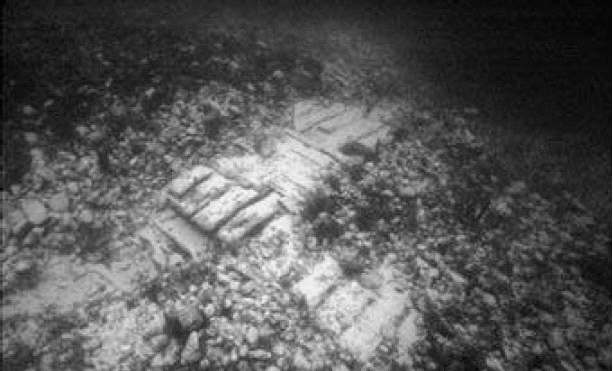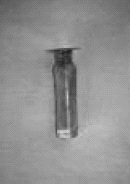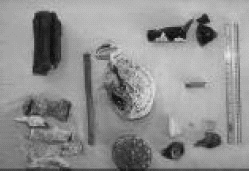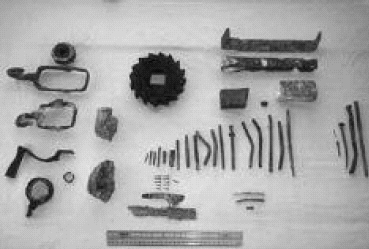



Connections Through Time, Issue 21: October
- December 2003
![]()
"... it is our view that what is going on in all Remote Viewing is a transaction involving everyone defined by intention and agreement as being part of the experiment. We are in essence faced with an engineering problem in which a bio-circuit made up of all participants is created by intention. ... Practically, this means what everyone feels, thinks, and intents is a factor in the protocol." - Stephan Schwartz and Randall J. De Mattei -- The Mobius Society |
 |
|
The timbers of the brig Leander,
represent a rare case on the Bahamas Banks of a shipwreck that is still
intact. This is because Leander probably sank while at anchor.
The Remote Viewing description of timber stacked like “railroad ties”
seemed particularly apposite.
(Reference). |
 |
| Remote Viewing predicted “small glass bottles” would be found, and they were. |
 |
| Remnants of containers.
Of particular interest is the pewter cruet in the center; it had been
predicted by Remote Viewing. |
 |
| Examples of ship fittings. These were used to establish the identity of the Leander. Several were predicted in the Remote Viewing sessions, particularly the ratchet wheel, top center. (Reference). |
Stephan Schwartz and the Moebius Group have successfully conducted several archeological studies using remote viewing. The approach for finding the sunken ship is discussed in detail here, and we will provide only a very brief summary based on their report.
In 1987 Mobius began fieldwork in an area of the Grand Bahama Banks encompassing some 579.15 square miles (1500 sq. km). Their report compares the Remote Viewing, electronic remote sensing, and visual search process used to locate the wreck site of a previously undiscovered armed American merchantman believed to be the Brig Leander. Remote Viewing was the source of information which led to the site’s location. The probability of finding this sunken brig, by chance, is conservatively estimated to be p = 0.00009. This is equivalent to odds of 10,000 to 1 that this brig was found by chance alone.
In addition to location information, there was a great deal of descriptive data concerning what would be found. For example, “I feel wood, big pieces of wood, like railroad ties…”. (See Figures at right.) This may sound generic. It is not. The massive timbers of the Leander are a rare case of a ship that sank intact. There is no other ship recovery on record in the License Area that matches this site. There does not seem to have been another equivalent reported excavation like this on the entire Banks.
Another description from the transcripts predicts “and small glass bottles.” Small glass bottles rarely survive the constant movement of sand, and currents on the Bank. The probability of discovering one is very small. Yet two were found in the wreckage of this site. There were a total of 193 conceptual descriptive concepts concerning the site were proffered by the twelve Remote Viewers. Of this, 148 concepts, or 75% of the total, could be evaluated through direct field observations, or historical research. An evaluation of this material reveals 84% Correct, 12% Partially Correct, 4% Incorrect. There is little accuracy variation across the sequence of material from the Los Angeles interviews ( 84% Corr., 13% Part. Corr., 3% Incorr.), to the on-site data (81% Corr., 11% Part. Corr., 8% Incorr.).
From where and from when does the information concerning the location of the brig and description of recovered artifacts come? First of all, let's accept that nobody really knows except to say that it involves consciousness acquiring normally hidden information.
A very general RV theory exists and is described in the CRV Manual. This theory posits a "signal line" connecting the RVer to a "matrix" that basically contains all information about everything (physical and non-physical) in the universe. This matrix is another way of saying that the unconscious or subconscious has access to everything.
A Link Theory also exists that basically says that events are linked in time such that the future can be a cause of actions in the past. Precognition is one of the predictions of this theory.
There is a large body of reproducible experimental data demonstrating the reality of precognition. We believe there is considerable value in considering the ideas of connections through time which basically form a strongly connected unit where actions in the past, present and future are so intimately connected that time-sequences are of minimal importance. It is as if the connected unit occurs all at once...or outside of time.
Intention and agreement, in a remote viewing context, were key to successfully finding the sunken brig (see the quote at the beginning of this section). Given the agreed-upon mindset of success, we hypothesis that the remote viewers were psychically in touch with the successful outcome of the project, and some of their sessions may have included precognitive information from the actual results observed in the future.
Thus, the accuracy of these RV predictions may be related to the viewers being in touch with the details of the successful outcome of the project. This hypothesis is different from the viewpoint that the RVers gathered their information based on viewing the site as it existed when they were doing their RV sessions or when the ship first sunk. For example, the small glass bottles could possibly have been viewed while in the sunken brig, or they could have been viewed as part of the successful recovery efforts. Note that this latter approach avoids the problem of the glass being broken after the ship was sunk or during the recovery process. Also, during the recovery and analysis process, there were people quite conscious of the glass bottles. Perhaps this conscious awareness was available to the RVers at earlier times.
Thus, this hypothesis implies that precognition is part of the explanation for the successful outcome.Note that once precognition of the actualized consciously known results is accepted, then alternate explanations become possible for the remarkable results of two other RV projects discussed in the following sections.
References
THE DISCOVERY OF AN AMERICAN BRIG: FIELDWORK INVOLVING APPLIED REMOTE VIEWING
INCLUDING A COMPARISON WITH ELECTRONIC REMOTE SENSING, Stephan A. Schwartz and Randall J. De Mattei -- The Mobius Society
Go to another section of
this issue:
Intuition: A Secret Soviet Site
Applications: The 1973 Remote Viewing Probe of the Planet Jupiter
![]()